Key Points:
- According to the chain’s data, Optimism’s assets have continuously increased.
- A standardized collection of open-source modules known as the OP stack is used to create rollup chains on Ethereum that are more expressive and exact.
- With the decoupling of various functional levels and the combination of all levels into an API software stack, the OP stack significantly streamlines the process of building modular blockchains.
Optimism, as one of the twin stars of Ethereum’s second-layer op-rollup, has recently become a hot topic due to the sharp rise in token prices and quest activities.
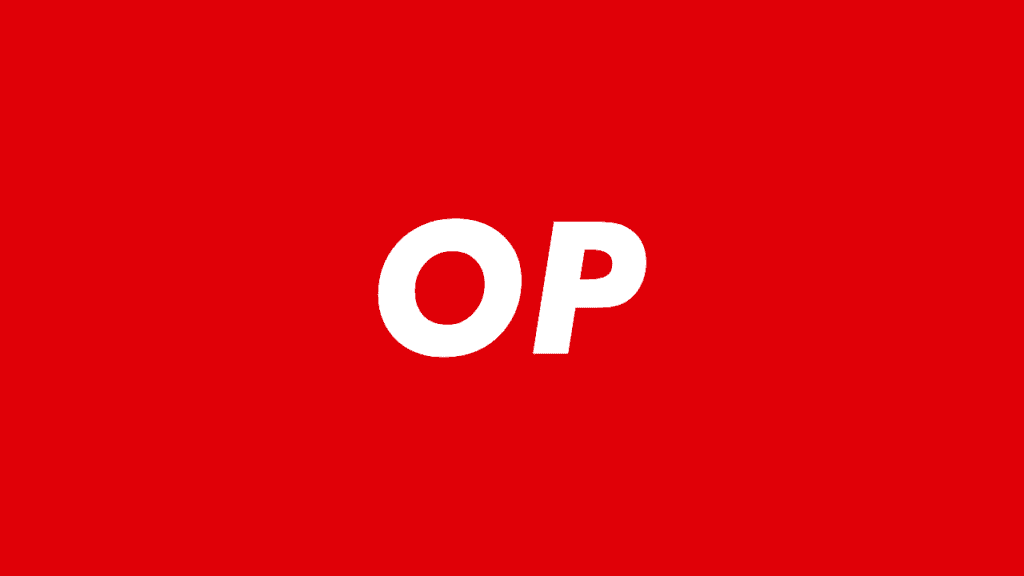
Optimism on-chain status
Judging from the data on the chain, OP’s assets on the chain have grown steadily, with a total value of nearly $2.7 billion; the daily transaction volume has declined after the Quest event but remains stable at about 400,000 per day; the number of unique users exceeds 1.7 million people; the gas fee is 150 times lower on average than the Ethereum mainnet.
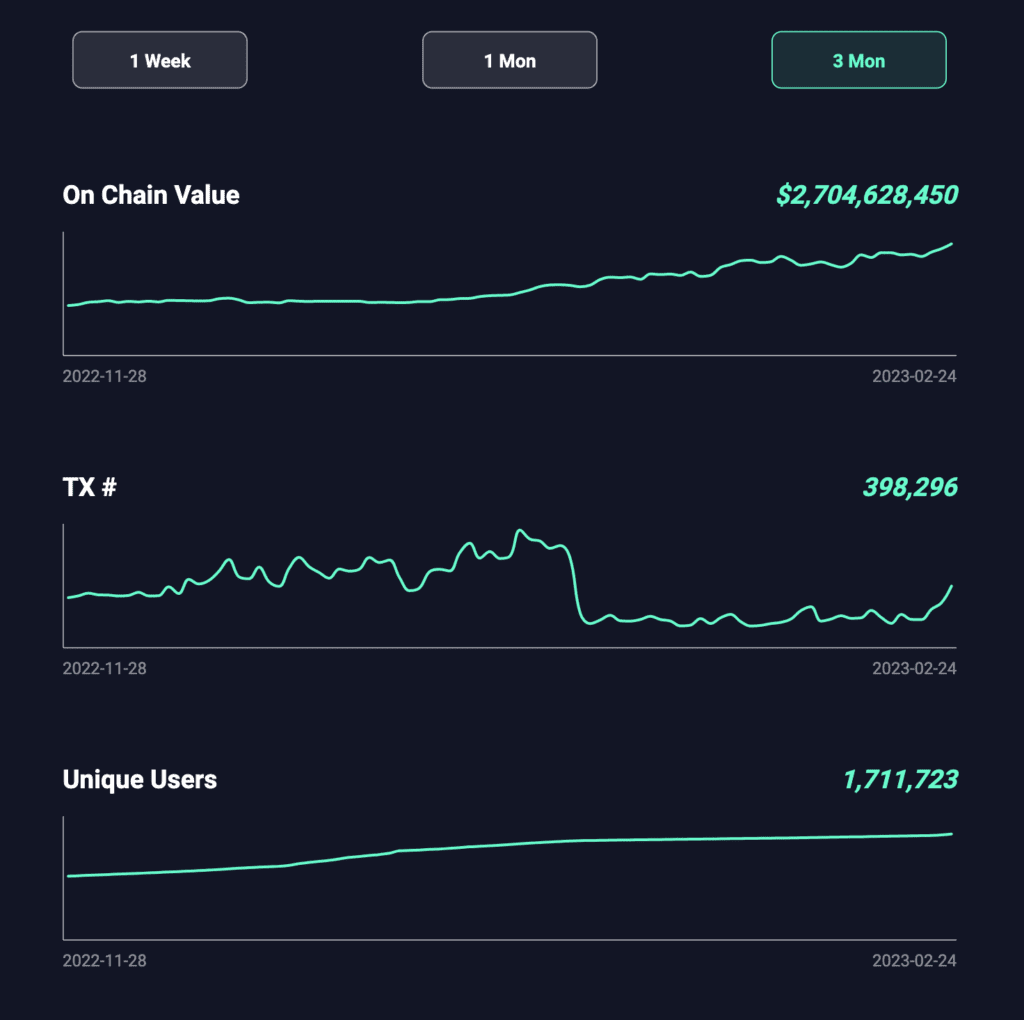
So how can the OP ecosystem be able to attract and accommodate abundant on-chain activities and the influx of funds?
OP Player’s Handbook
Although OP is Layer 2 of Ethereum, it is essentially a general-purpose public chain. This part uses Chaineye’s OP section to provide some guidelines for crypto players exploring the OP ecosystem.
DeFi
DeFi will always be the highlight of the public chain. The prosperity and innovation of DeFi projects will attract and accommodate a large amount of liquidity, just like injecting fuel into the engine, revitalizing the entire public chain ecosystem. OP’s DeFi ecosystem is relatively complete, with decentralized exchanges, lending, and more.
In addition to the migration of Ethereum’s leading projects, there are also some native projects, such as Velodrome. These ecosystem projects are supported by OP, and they can also receive additional staking rewards of OP tokens when adding liquidity.
DEX
According to Chaineye, the largest DEX on OP is Velodrome, and TVL is far ahead of all DEX projects, even surpassing the second-place Curve by order of magnitude.

Velodrome is one of the featured projects on the OP. It is positioned as a dex modeled on Solidly. It hopes to build a major trading and liquidity market on Optimism and integrates Solidly, Curve, Olympus DAO, Votium such as veToken, and games. At the same time, the rules of token distribution, release, and incentives have been optimized to help incentives flow to the most valuable ecosystem liquidity pool.
There are two types of tokens in Velodrome. VELO is an ERC20 token that can be obtained through staking. veVELO is an NFT governance token with similar functions to veCRV.
In the past half a year, almost all of the newly added VELO was used for lock-up, which shows the effectiveness of the (3,3) mechanism. Various smart pool projects are actively accumulating more veVELO, and veVELO holders mainly. The income comes from bribery, which makes the project more efficient in attracting liquidity.
The core function of Velodrome is to allow users to exchange digital assets with low fees and low slippage. The transaction fee is only 0.02%~0.05%. Even without the liquidity aggregation of Uniswap V3, users will get better due to the lower fee experience.
Since Velodrome launched op token incentives in August last year, TVL has skyrocketed, surpassing Uniswap and Curve, and has long dominated the list of OP TVL in the following days. Judging from the data of DefiLlama, Velodrome’s current TVL is about $293 million, accounting for 32.4% of the entire OP chain. It is undoubtedly one of the most noteworthy projects on OP.

Since OP is an EVM-compatible chain, some leading projects on Ethereum can migrate over smoothly, so large projects such as Uniswap V3, Curve, and KyperSwap are also deployed on OP, and friends who are used to using these can also maintain their original preferences.
Other OP DEXs such as Beethoven X and Rubicon are also worthy of attention. Beethoven X aims to be a one-stop decentralized investment platform. In addition to the Swap function, as shown in the figure below, it will provide investment portfolio recommendations based on hot sectors and one-click portfolio investment.
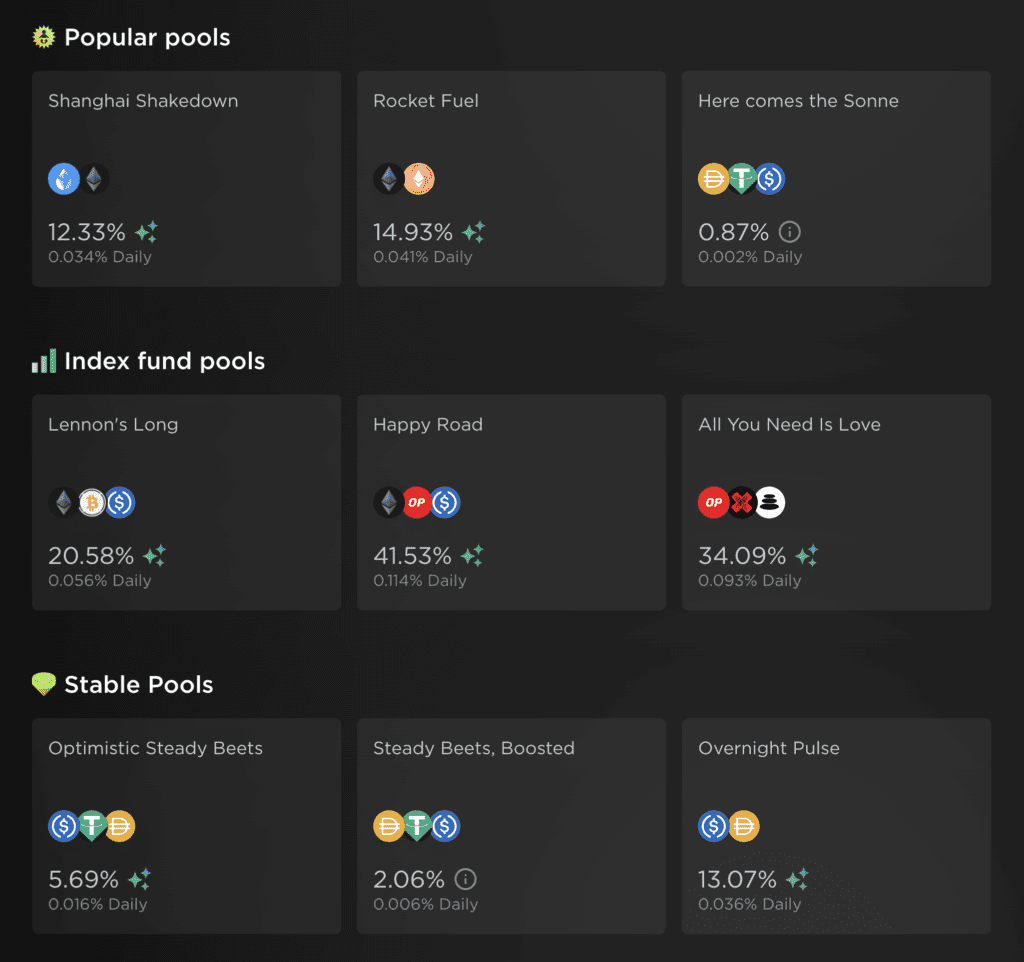
Rubicon is an order book-based DEX designed to develop and introduce equity and digital asset markets on the Ethereum blockchain. By staking a single token, you can also get OP token rewards.

Lending
AAVE, the leading Ethereum lending project, launched the V3 version on OP, which has functions such as asset cross-chain flow, high-efficiency mode, and an isolation mode to support long-tail asset lending, with a significant head effect.
Sonne Finance is OP’s native lending platform, and it is also the second-largest TVL among lending projects. The platform offers currency markets for wETH, USDC, USDT, DAI, OP, sUSD, wBTC, and SNX. Sonne uses Velodrome in their token strategy as they do not simply reward liquidity providers with SONNE tokens.
Instead, they bribed VELO holders with SONNE tokens to vote for the SONNE/USDC pair, and users who staked SONNE tokens were instead rewarded with VELO. The OP has the opportunity to build his own native DeFi Lego based on Velodrome, and Sonne is the lending part.
The rest of the lending platforms, such as dForce, Hundred Finance, etc., are multi-chain deployment lending protocols, but the overall TVL and LTV are not too strong.
Derivative
The complete DeFi ecosystem also includes financial derivatives on the chain. Through composability, more innovations can be born, and more projects can be nurtured. The power of the flywheel driven by GMX on Arbitrum can be seen.
For financial derivatives on the OP, in addition to the migration of the Ethereum head product Perpetual, there is also Pika Protocol. Pika is a stablecoin backed by decentralized derivatives. It consists of two parts: Pika Exchange and PIKA Stablecoin.
Pika Exchange is a perpetual contract exchange that supports leveraged trading. It supports token-based reverse perpetual swaps. The foundation of the exchange is the Virtual Automated Market Maker (vAMM). The PIKA stablecoin is a stablecoin backed by Pika Exchange with the following characteristics: Stable: It uses perpetual swap positions to support its price stability around the $1 target.
PIKA is minted by opening a 1x inverse perpetual swap short position. Capital Efficiency: Minting PIKA by depositing a dollar worth of supported tokens (e.g., ETH, WBTC) achieves better capital efficiency than over-collateralized stablecoins.
There are also OP token rewards at the beginning of Pika’s launch, and the greater the transaction volume, the more rewards.
Farming
Regarding stablecoin liquidity mining, you can refer to Chaineye’s yield section, so we won’t go into details. The composition, income, and TVL of each pool are all clear at a glance.
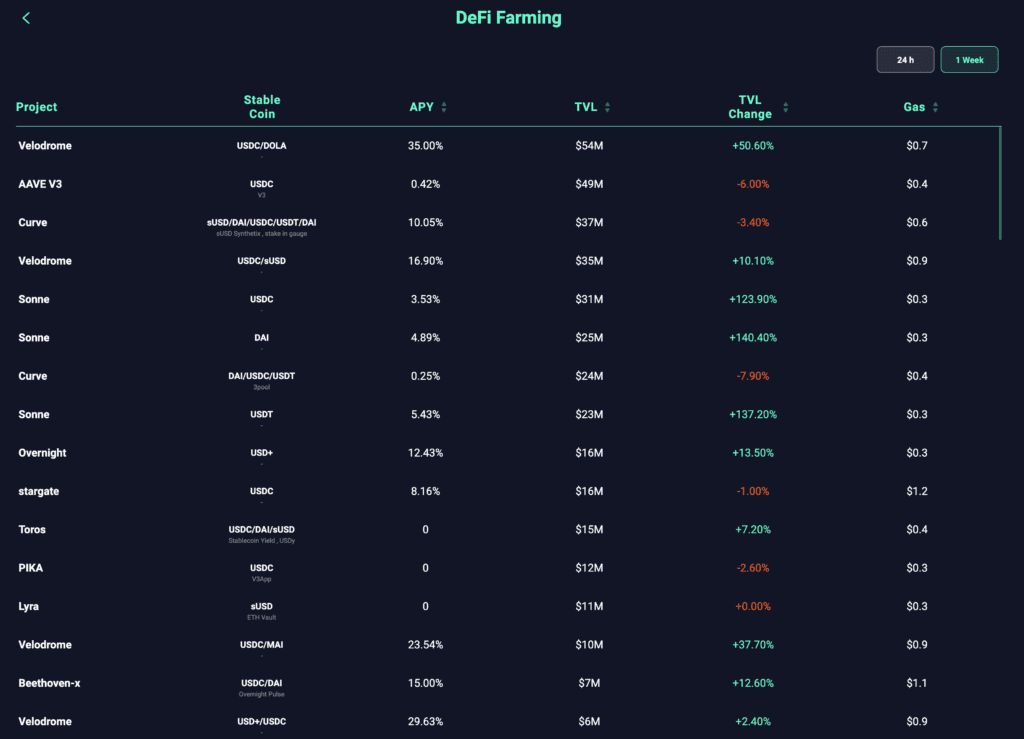
NFT Marketplace
Quix is Optimism’s first native NFT marketplace platform where users can search, collect, buy, and sell NFTs. Users can also start their own NFT projects through Launchpad, allowing the deployment of code-agnostic NFT smart contracts and minting pages.
The low handling fee brought by Layer 2 helped users save nearly $300,000 in fees. Due to funding issues, Quix has been shut down, and Quix Launchpad also ceased service on January 16 this year.
This vacancy can currently focus on NFTEarth, which has multiple rounds of airdrop plans, and OG cards can also be purchased in the secondary market.
Game
On-chain game developer Lattice launched OPCraft, an on-chain voxel world that is almost identical to Minecraft, on OP Stack.
In this virtual world, every component, from rivers to diamonds, exists on the chain, and every action of the player, from digging to construction, happens as a real transaction on the chain. Relying on the custom chain of Optimism’s modular Rollup architecture OP Stack, it can support such a high throughput on the chain.
The game’s rollup test chain is currently frozen, but this is a very good OP stack experiment. In the future, keep an eye on Lattice’s games based on the OP stack, and there should be better chain games and participation opportunities.
Summary: When exploring the OP ecosystem, it is best to pay more attention to the projects that participate in the original OP. Such projects will generally receive early support from OP, that is, OP token rewards.
OP stack technology introduction
Today, most chains are pursuing their own modular strategies. Optimism, Arbitrum, and Starknet differ in their execution layers, but they all share the same settlement, consensus, and data availability layers by outsourcing these layers to the Ethereum mainnet.
Each chain runs its own independent strategy, with differences in the design of the execution, settlement, and data availability layers. What if these chains shared a standardized open-source code base rather than the siled chain/rollup system of today?
This is where Optimism’s OP Stack comes in: a standardized set of open-source modules for building more expressive and precise rollup chains on Ethereum.
Modular technology
What is the role of modularity?
To put it simply, modularization is like dressing up. Ethereum is now like a one-piece suit. Even if you think the clothes are not suitable or the color is not good-looking, you can’t change them. But if we divide the dress into three major modules: tops, pants, and shoes, we can create different images by matching different materials and colors.
The modularization of the blockchain is to separate the execution of transactions, bookkeeping, and synchronization of ledgers to several people. It does not need to be done by one person from beginning to end, which is tiring and slow.
OP Stack is an important step in OP’s modular blockchain, and it is also an important step in exploring modularization from theory to practice. The OP divides the blockchain into three layers by function: the consensus layer, the execution layer, and the settlement layer.
Executive layer
The execution layer, as the name suggests, is to execute transactions. If A transfers 2 ETH to B, add -2 ETH to A’s balance and add 2 ETH to B’s balance. For example, Optimism, as Ethereum’s Rollup, aims to execute transactions instead of Ethereum and only return results. Ethereum believes in the result returned by the OP in an optimistic way while leaving a challenging period to prevent evil.
Settlement layer
The role of the settlement layer is to verify the transaction. If the verification is correct, it will stamp you and generate a state root.
Consensus layer
The blockchain is an open ledger, and the consensus layer is to synchronize everyone’s respective ledgers to ensure consistency. There is a concept called data availability, referred to as the DA layer, which refers to the fact that the ledger records a result (state root). If I want to trace and verify the calculation process, I need the calculated data at that time.
The DA layer is where these data are stored, and having a DA layer ensures that you can find these data.
What are the benefits of modularity?
The advantage is that different “parts” can be replaced according to the needs of the project, enhancing the composability of the blockchain.
The vision of the OP stack
OP stack decouples different functional levels and combines all levels in the form of an API software stack, which greatly simplifies the process of modular blockchain construction.
Each layer of the OP Stack is described by a defined API populated by modules at that layer. In theory, OP Stack can build any modular blockchain based on its API.
Developers do not need to build a blockchain from 0 to 1. The ready-made code base based on OP Stack can realize the rapid deployment of modular blockchains and can easily modify existing modules or create their own new modules to meet the needs of any application.
Each of the OP stack components implements a specific layer of the stack that powers. Optimism’s next-generation architecture as follows:
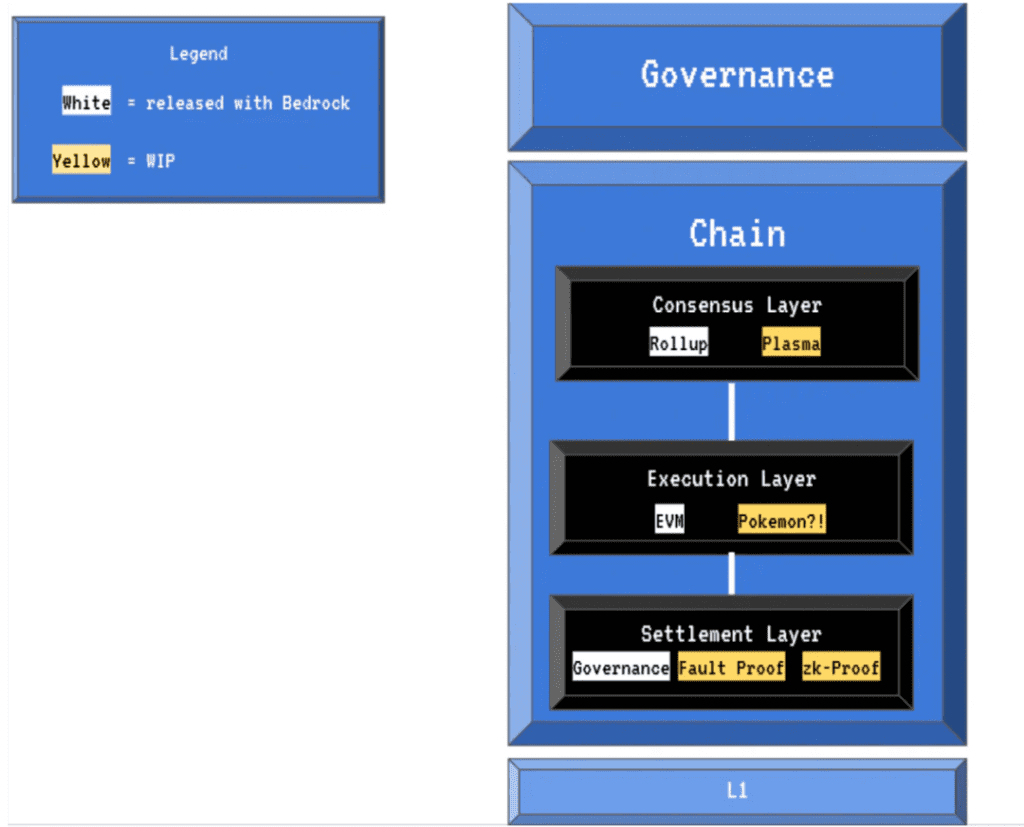
Specific applications such as a chain can replace the DA layer from Ethereum to Celestia to realize the separation of the DA layer, switch the fraud-proof module of the execution layer to a validity proof, and realize the conversion from OP rollup to zk Rollup.
The modular stack brings greater autonomy to developers, being able to switch, replace, and modify different module levels, just like switching APIs.
In the future, by sharing the messaging format, OP Stack-based chains can communicate with each other and achieve interoperability, thereby realizing the vision of a “super chain.” When multiple op-chains share a Sequencer Set, they gain a nice feature: atomic cross-chain composability.
A sequencer that produces blocks on multiple chains simultaneously can guarantee atomic interactions between these chains. Op-chains opting into the Optimism Collective’s shared Sequencer Set become part of the system, and the boundaries between chains disappear. Even though it consists of multiple chains, adding atomic cross-chain interactions means that it feels like a single logical chain to the end user.
The OP proposed that the end result of the blockchain is neither a multi-chain nor a single-chain structure but a “super chain” structure composed of a group of highly integrated OP Stack chains.
How OP stack will change the OP ecosystem
OP is currently working on improving the first version of the OP stack — the Bedrock upgrade. The ecosystem based on the OP stack needs to be further expanded on the basis of perfect tools.
So what changes will OP Stack bring to the OP ecosystem?
First of all, we no longer stick to the concept of “projects on the OP chain” but explore the concept of the “OP universe.” As the OP Stack matures, Optimism will be very close to the realization of the Cosmos, with OP as the core to build the OP universe.
“One-click release chain” will become a feature of OP. Based on the standardization of OP, L2 and L3 will grow explosively. Appchain can play “Blockchain Lego” on this basis. By combining various characteristic VMs and technologies, there are unlimited possibilities. Innovation and possibility.
At the same time, each modular blockchain based on the OP stack can achieve interoperability in the OP universe, and the shared messaging format between chains can easily communicate with each other.
How to participate in this OP modular reform?
As a developer, you can pay close attention to the release and update of the OP stack and issue application chains on this basis; as a crypto user, you can participate in each application chain as soon as possible. If the OP official wants to promote the development of the OP stack, incentives for users are essential.
And judging from the OP ecosystem incentives and recent retroactive airdrops for users, the OP’s point of view is very clear: influence creates wealth. If you want to benefit from the OP ecosystem, you must either create influence – build an innovative dapp based on the OP stack, or become an influence – participate in new dapps as soon as possible.
DISCLAIMER: The Information on this website is provided as general market commentary and does not constitute investment advice. We encourage you to do your research before investing.
Join us to keep track of news: https://linktr.ee/coincu
Harold
Coincu News














